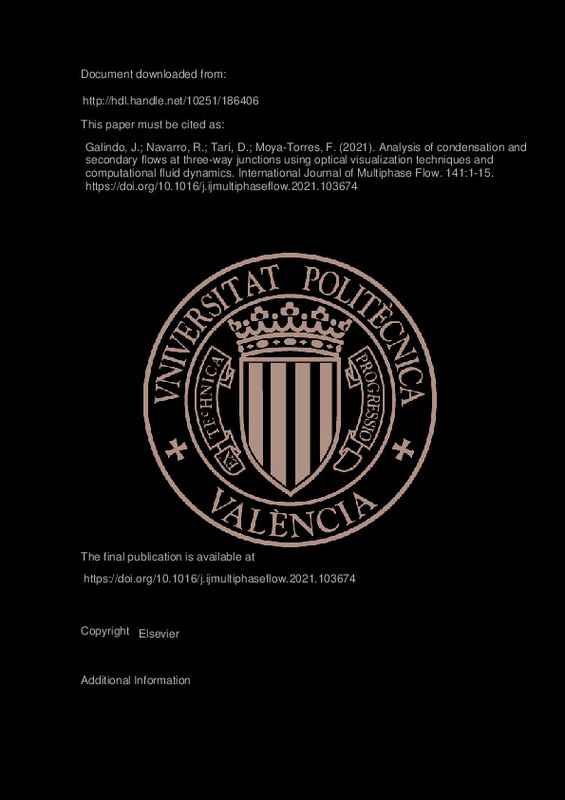JavaScript is disabled for your browser. Some features of this site may not work without it.
Buscar en RiuNet
Listar
Mi cuenta
Estadísticas
Ayuda RiuNet
Admin. UPV
Analysis of condensation and secondary flows at three-way junctions using optical visualization techniques and computational fluid dynamics
Mostrar el registro sencillo del ítem
Ficheros en el ítem
| dc.contributor.author | Galindo, José
|
es_ES |
| dc.contributor.author | Navarro, Roberto
|
es_ES |
| dc.contributor.author | Tarí, D.
|
es_ES |
| dc.contributor.author | Moya-Torres, Francisco
|
es_ES |
| dc.date.accessioned | 2022-09-20T18:03:49Z | |
| dc.date.available | 2022-09-20T18:03:49Z | |
| dc.date.issued | 2021-08 | es_ES |
| dc.identifier.issn | 0301-9322 | es_ES |
| dc.identifier.uri | http://hdl.handle.net/10251/186406 | |
| dc.description.abstract | [EN] Three-way junctions are employed in almost all piping systems, whenever two streams need to be merged into one duct. In some applications, the mixing between streams plays an important role for determining the performance of downstream elements. The situation is particularly interesting for low pressure Exhaust Gas Recirculation (EGR) junctions featured in piston engines, where warm humid exhaust gases meet cold fresh air, since the mixing of both streams can produce water condensation. This condensation deteriorates the integrity and performance of the adjacent compressor wheel. This work explores the aforementioned flow configuration in a three-way junction by means of a novel gas test bench that allows the characterization of the transversal section at the junction outlet, and 3D Computer Fluid Dynamics (CFD) simulations embedded with a previously-developed condensation model. Two optical techniques are employed: laser particle image velocimetry, which is used to characterize the cross-section secondary flows, and planar laser-induced visualization, which is employed for the first time to obtain the condensation pattern. The experimental measurements are conducted at two different working points and for two different three-way junction designs, being in agreement with 3D CFD simulations. Particularly, the overall luminosity captured in the experiments presents the same trends than the numerical condensed mass fraction. This innovative validation proves that a CFD model employing a psychrometric-based condensation submodel can be used as a tool to quantify the condensation produced in a three-way junction. The proposed tools are shown to be helpful for the development of advanced LP-EGR systems to reduce NOX, CO2 and particulate matter emissions during engine warm-ups. | es_ES |
| dc.description.sponsorship | This work has been partially supported by "Conselleria de Innovacion, Universidades, Ciencia y Sociedad Digital de la Generalitat Valenciana" through grant number GV/2020/008. Francisco Moya is partially supported through a FPI-GVA-ACIF-2019 grant of the Government of Generalitat Valenciana and the European Social Fund. The authors of this paper wish to thank Alejandro Hernandez Salmeron and David Gonzalez Dominguez for his invaluable support during the laboratory setup and the experimental campaign and Jose Vicente Pastor for his support regarding the optical techniques. | es_ES |
| dc.language | Inglés | es_ES |
| dc.publisher | Elsevier | es_ES |
| dc.relation.ispartof | International Journal of Multiphase Flow | es_ES |
| dc.rights | Reconocimiento - No comercial - Sin obra derivada (by-nc-nd) | es_ES |
| dc.subject | Optical techniques | es_ES |
| dc.subject | Three-way junction | es_ES |
| dc.subject | In-flow condensation | es_ES |
| dc.subject | Mixing streams | es_ES |
| dc.subject | Low-pressure EGR | es_ES |
| dc.subject.classification | MAQUINAS Y MOTORES TERMICOS | es_ES |
| dc.title | Analysis of condensation and secondary flows at three-way junctions using optical visualization techniques and computational fluid dynamics | es_ES |
| dc.type | Artículo | es_ES |
| dc.identifier.doi | 10.1016/j.ijmultiphaseflow.2021.103674 | es_ES |
| dc.relation.projectID | info:eu-repo/grantAgreement/GENERALITAT VALENCIANA//ACIF%2F2019%2F026//AYUDA PREDOCTORAL GVA-MOYA TORRES. PROYECTO: CONTRIBUCION AL MODELADO DE LA CONDENSACION DE AGUA EN EL SISTEMA DE EGR DE BAJA PRESION EN OPERACION A BAJA TEMPERATURA./ | es_ES |
| dc.relation.projectID | info:eu-repo/grantAgreement/GENERALITAT VALENCIANA//GV%2F2020%2F008//ANALISIS Y MODELADO DE LA CONDENSACION EN LA LINEA DE EGR DE BAJA PRESION EN UN MOTOR DE AUTOMOCION EN CONDICIONES DE BAJA TEMPERATURA/ | es_ES |
| dc.rights.accessRights | Abierto | es_ES |
| dc.contributor.affiliation | Universitat Politècnica de València. Departamento de Máquinas y Motores Térmicos - Departament de Màquines i Motors Tèrmics | es_ES |
| dc.description.bibliographicCitation | Galindo, J.; Navarro, R.; Tarí, D.; Moya-Torres, F. (2021). Analysis of condensation and secondary flows at three-way junctions using optical visualization techniques and computational fluid dynamics. International Journal of Multiphase Flow. 141:1-15. https://doi.org/10.1016/j.ijmultiphaseflow.2021.103674 | es_ES |
| dc.description.accrualMethod | S | es_ES |
| dc.relation.publisherversion | https://doi.org/10.1016/j.ijmultiphaseflow.2021.103674 | es_ES |
| dc.description.upvformatpinicio | 1 | es_ES |
| dc.description.upvformatpfin | 15 | es_ES |
| dc.type.version | info:eu-repo/semantics/publishedVersion | es_ES |
| dc.description.volume | 141 | es_ES |
| dc.relation.pasarela | S\437724 | es_ES |
| dc.contributor.funder | European Social Fund | es_ES |
| dc.contributor.funder | GENERALITAT VALENCIANA | es_ES |
| dc.subject.ods | 13.- Tomar medidas urgentes para combatir el cambio climático y sus efectos | es_ES |







![[Cerrado]](/themes/UPV/images/candado.png)

